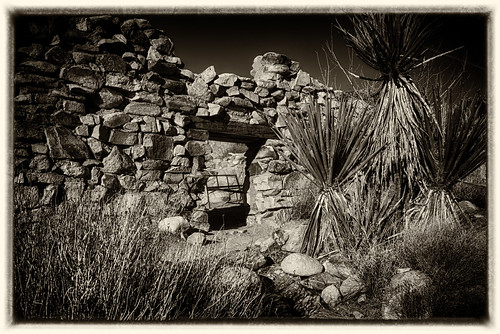The Desert Queen Mine
I saw an opportunity to strike it rich and took it. Driving along the road, I glanced upon a sign, Desert Queen Mine. I slammed on the breaks, threw on some 10 inch heels and a Tiara, put on some cheap mascara, slapped myself to make me cry so the mascara would run and ran down the trail to the edge of a cliff looking over the Desert Queen Mine and decreed, "I Claim This Mine to be mine!" Then one of my 10 inch heels broke, I rolled down the mountain, lost my tiara, got so much dirt on my face you couldn't see the mascara and crashed to the bottom of the valley face down in the dirt right next to Anderson Cooper who was wearing a tiara, runny mascara and sensible shoes.
View on black or I'll chuck my tiara at you (it's BIG)
for
113 pictures in 2013: Made of Stone or Rock
--------------------------------------------------------------------
Taken from the National Register of Historic Places
The Desert Queen Mine is of local historical significance under the category of
Industry and the subcategory of mining, being one of the more successful and longer-lived
mines of high desert country of Southern California in Joshua Tree National Monument.
Its history was all too typical of southwestern desert frontier mines. It brought death
rather than fortune to its discoverer, and its subsequent owner lost it to a financial
institution. Its operation was sporadic, but it occasionally offered up a pocket of gold
ore sufficiently rich to maintain interest in intermittent operation for nearly three
quarters of a century. It was associated with a notorious local outlaw. Its tunnels,
inclined shafts and shafts represent three basic types of mine approach which were
typical of southwestern desert mines, but the Desert Queen Mine was more productive and
far longer-lived than most of its contemporaries.
The above statement of significance is derived from the following sketchy and inadequate
historical data:
A, James discovered the outcropping of gold ore which he developed as the Desert Queen
Mine during the early 1890s; although one source claims that-the discovery was made in
1894, another cites 1893 as the year of James' death. The ore processed initially was
apparently quite rich, and a local cattle rustler named Jim McHaney decided to take over
the mine. He sent two cronies, Charley Martin and a man named Myers, to force James to
sign over the mine. James refused, so Martin borrowed a gun from Myers and forced James
to sign, then shot him. Martin was tried for murder, claimed self defense, and was
acquitted.
McHaney's first ore shipments reportedly netted him $27,000, but he spent it quickly
and then borrowed from a local bank against future production. When subsequent ore
shipments proved unable to keep up with his borrowing, the mine passed into ownership of
the bank. It was later owned by several individuals, passing into the hands of William
F. Keys possibly in 1917. Keys operated the mine intermittently until 1961.
Thursday, April 11, 2013
The Desert Queen Mine
Subscribe to:
Post Comments (Atom)

No comments:
Post a Comment